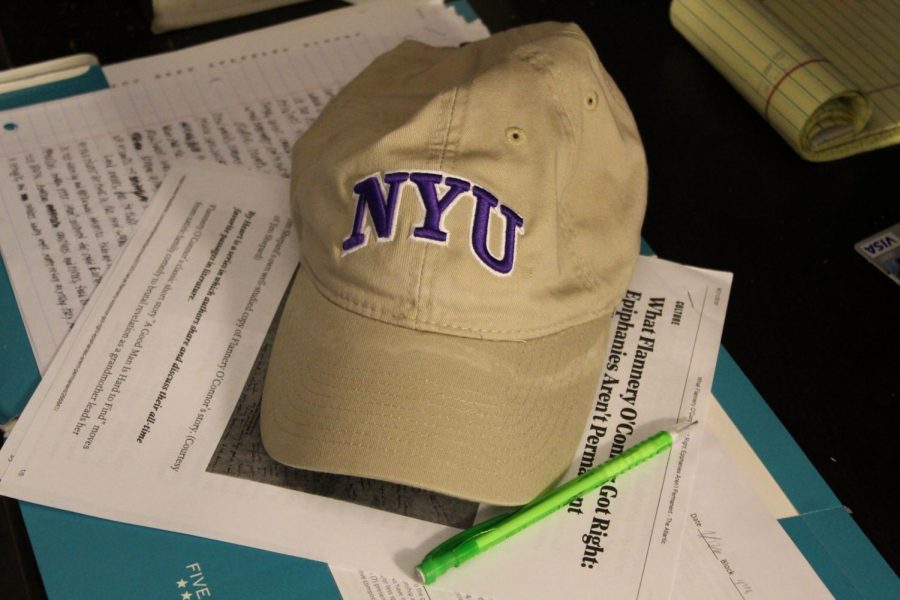The Hat Crusade
Hats have been a controversial topic in Weddington since the school’s opening in 2000.
There are all kinds of potential distractions one could run into during a school day. Maybe the people next to you are talking when you are trying to study. Maybe you’re tempted to talk about football instead of doing a group project. Maybe you spend time on games you could be spending on homework. Maybe you are wearing a hat.
Yes, hats have been always been a topic of debate at Weddington, but last year the hat rule was the closest it’s ever been to being removed. It was announced that faculty members had discussed reallowing head apparel, and eventually came the conclusion that the school better off with the ban. Was this the right decision do hats have a negative effect on our school community? Does what’s on our head really harm our ability to learn? I sat down for a brief interview with Jacob Atkinson, who frequently wears a hat on school grounds. Every day I see him wear a different hat, each one adorned with the Bass Pro Shop logo. Jacob’s actions do not go unpunished, as his hats get taken away on a regular basis. Supposedly Weddington High School’s office is home to a pile of baseball caps awaiting pickup by a parent. I recently witnessed a teacher take Jacob’s hat, prompting him to reach into his bag and produce another. This is a sacrifice he is willing to make.
I asked Jacob about this small rebellion he had begun. “I don’t see how hats are any different than hair,” Jacob argued. “I may have a bad hair day, but you wouldn’t know, because I’m wearing a hat.” He stood firm in his belief that having a hat on largely goes unnoticed, and has no negative effect on him or his classmates. What he said was actually quite the opposite: “(Hats are) not only a part of my look, (they’re) a part of who I am.” Isn’t it worse if a students exist in an environment that limits our ability to express ourselves? Jacob has no intention of distracting or offending fellow students, and there is no reason that a hat would change this about a person. “If someone is allowed to have long hair or short hair, I think we should be allowed to wear hats,” said Jacob. Don’t hats occupy the same amount of space that our hair does? Having fabric on your head can’t be much different than the fabric on a t-shirt or a hoodie. Any inappropriate images, statements, or symbols attached to a hat could just as easily be attached to other apparel, couldn’t they?
Another argument frequently brought up in argument against headgear is that wearing a hat indoors is disrespectful. I brought this up to Jacob, who responded, “That’s what everyone grew up doing… it’s pretty common.” He isn’t wrong, especially considering that this generation was raised on values such as respectful self-expression rather than etiquette. When a Millennial or Generation Z person wears a hat indoors, it’s not offensive, it’s just a personal decision they made for themselves. That being said, a hat is still an informal piece of clothing. You wouldn’t wear your favorite snapback to a religious event or to an office. School is supposed to be a learning environment, not a casual setting. Regardless of that, politeness and formality are ideals that work better when they are suggested instead of enforced. How can you judge a person’s character if everyone’s character is forced to be the same? How do you know if someone is impolite if they have been denied the right to act for themselves? Making good manners a choice makes those who choose to have them shine even brighter.
The bottom line is this: a ban on hats has no positive outcomes. At best, the rule punishes students who were minding their own business, like Jacob. At worst, it needlessly strips students of their individuality. Those of us who attended Weddington Middle know that being able to choose your outfit is a big deal. There is a reason high schoolers don’t have a strict dress code. We are old enough to make our own choices about what we wear, and we are also old enough to accept the natural consequences, good or bad, brought on by the decisions we make. I know the Weddington Warriors can make the right choices. Trust goes both ways, so why not give students a chance to prove it?










